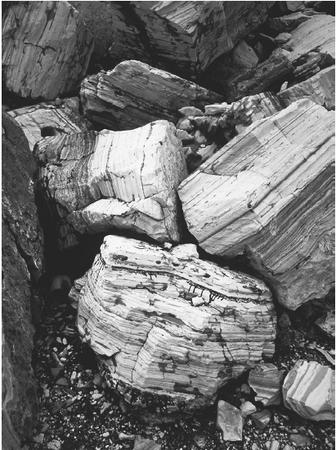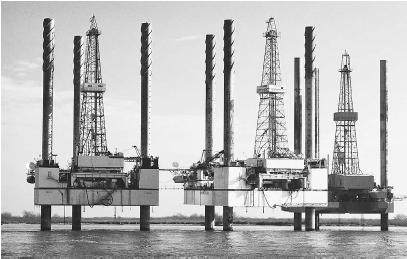Economic Geology - Real-life applications
Fossil Fuels
The organic material that has decomposed to create the hydrocarbons in fossil fuels comes primarily from dinosaurs and prehistoric plants, though it just as easily could have come from any other organisms that died in large numbers a long, long time ago. To form petroleum, there must be very large quantities of organic material deposited along with sediments and buried under more sediment. The accumulated sediments and organic material are called source rock.
What happens after accumulation of this material is critical and depends a great deal on the nature of the source rock. It is important that the organic material—for example, the vast numbers of dinosaurs that died in a mass extinction about 65 million years ago (see Paleontology)—not be allowed simply to rot, as would happen in an aerobic, or oxygen-containing, environment. Instead, the organic material undergoes transformation into hydrocarbons as a result of anaerobic chemical activity, or activity that takes place in the absence of oxygen.
Good source rocks for this transformation are shale or limestone, provided the particular rocks are composed of between 1% and 5% organic carbon. The source rocks should be deep enough that the pressure heats the organic material, yet not so deep that the pressure and temperature cause the rocks to undergo metamorphism or transform them into graphite or other non-hydrocarbon versions of carbon. Temperatures of up to 302°F (150°C) are considered optimal for petroleum generation.
Once generated, petroleum gradually moves from the source rock to a reservoir rock, or a rock that stores petroleum in its pores. A good reservoir rock is one in which the pore space constitutes more than 30% of the rock volume. Yet the rock must be sealed by another rock that is much less porous; indeed, for a seal or cap rock, as it is called, a virtually impermeable rock is preferred. Thus, the best kind of seal-forming rock is one made of very small, closely fitting pieces of sediment, for instance, shale. Such a rock is capable of holding petroleum in place for millions of years until it is ready to be discovered and used.
HUMANS AND PETROLEUM.
People have known about petroleum from pre-history, simply because there were places on Earth where it literally seeped from the ground. The modern era of petroleum drilling, however, began in 1853, when an American lawyer named George Bissell (1821-1884) recognized its potential for use as a lamp fuel. He hired "Colonel" Edwin Drake (1819-1880) to oversee the drilling of an oil well at Titusville, Pennsylvania, and in 1859 Drake struck oil. The legend of "black gold," of fortunes to be made by drilling holes in the ground, was born.
In the wake of the development and widespread application of the internal-combustion engine during the latter part of the nineteenth and the early part of the twentieth centuries, interest in oil became much more intense, and wells sprouted up around the world. Sumatra, Indonesia, yielded oil from its first wells in 1885, and in 1901, successful drilling began in Texas—the source of many a Texas-sized fortune. An early form of the company known today as British Petroleum (BP) discovered the first Middle Eastern oil in Persia (now Iran) in 1908. Over the next 50 years, the economic importance and prospects of that region changed considerably.
With the vast expansion in automobile ownership that began following World War I (1914-1918) and reached even greater heights after World War II (1939-1945), the value and importance of petroleum soared. The oil industry boomed, and, as a result, many geologists found employment in a sector that offered far more in the way of financial benefits than university or government positions ever could. Today geologists assist their employers in locating oil reserves, not an easy task because so many variables must line up to produce a viable oil source. Given the cost of drilling a new oil well, which may run to $30 million or more, it is clearly important to exercise good judgment in assessing the possibilities of finding oil.
The oil industry has been fraught with environmental concerns over the impact of drilling (much of which takes place offshore, on rigs placed in the ocean); possible biohazards associated with spills, such as the one involving the Exxon Valdez in 1989; and the effect on the


At the present rate of consumption, oil reserves will be exhausted by about the year 2040, but this takes into account only reserves that are considered viable today. As exploration continues, the tapping of United States reserves, such as those in Alaska, will become more and more profitable, leading to increased exploitation of U.S. resources and decreased dependence on oil produced by Middle Eastern states, many of which openly or covertly support terrorist attacks against the United States. In the long run, however, it will be necessary to develop new means of fueling the industrialized world, because petroleum is a nonrenewable resource: there is only so much of it underground, and when it is gone, it will not be replaced for millions of years (if at all).
PETROCHEMICALS.
In the meantime, however, petroleum—a mixture of alkanes, alkenes, and aromatic hydrocarbons—makes the world (or at least the industrialized world) go 'round. Petroleum itself is a raw material from which numerous products, collectively known as petrochemicals or petroleum derivatives, are obtained. Through a process termed fractional distillation, the petrochemicals of the lowest molecular mass boil off first, and those having higher mass separate at higher temperatures.
Natural gas separates from petroleum at temperatures below 96.8°F (36°C)—far lower than the boiling point of water. At somewhat higher temperatures, petroleum ether and naphtha, both solvents (naphtha is used in paint thinner), separate; then, in the region between 156.2°F and 165.2°F (69-74°C), gasoline separates. Still higher temperatures yield other substances, each thicker than the one before it: kerosene; fuel for heating and the operation of diesel engines; lubricating oils; petroleum jelly; paraffin wax; and pitch, or tar. A host of other organic chemicals, including various drugs, plastics, paints, adhesives, fibers, detergents, synthetic rubber, and agricultural chemicals, owe their existence to petrochemicals.
Silicon, Silicates, and Other Compounds
It was stated earlier that both carbon and silicon have the tendency to produce long strings of atoms, usually in combination with hydrogen in the first case and oxygen in the second. This is no accident, since silicon lies just below carbon on the periodic table of elements and they share certain chemical features (see Minerals). Just as carbon is at the center of a vast world of hydrocarbons, so silicon is equally important to inorganic substances ranging from sand or silica (SiO 2 ) to silicone (a highly versatile set of silicon-based products), to the rocks known as silicates.
Silicates are the basis for several well-known mineral types, including garnet, topaz, zircon, kaolinite, talc, mica, and the two most abundant minerals on Earth, feldspar and quartz. (Note that most of the terms used here refer to a group of minerals, not to a single mineral.) Made of compounds formed around silicon and oxygen and comprising various metals, such as aluminum, iron, sodium, and potassium, the silicates account for 30% of all minerals. As such, they appear in everything from gemstones to building materials; yet they are far from the only notable products centered around silicon.
SILICONE AND OTHER COMPOUNDS.
Silicone is not a mineral; rather, it is a synthetic product often used as a substitute for organic oils, greases, and rubber. Instead of attaching to oxygen atoms, as in a silicate, silicon atoms in silicone attach to organic groups, that is, molecules containing carbon. Silicone oils frequently are used in place of organic petroleum as a lubricant because they can with stand greater variations in temperature. And because the body tolerates the introduction of silicone implants better than it does organic ones, silicones are used in surgical implants as well. Silicone rubbers appear in everything from bouncing balls to space vehicles, and silicones are also present in electrical insulators, rust preventives, fabric softeners, hair sprays, hand creams, furniture and automobile polishes, paints, adhesives, and even chewing gum.
Even this list does not exhaust the many applications of silicon, which (together with oxygen) accounts for the vast majority of the mass in Earth's crust. Owing to its semimetallic qualities, silicon is used as a semiconductor of electricity. Computer chips are tiny slices of ultrapure silicon, etched with as many as half a million microscopic and intricately connected electronic circuits. These chips manipulate voltages using binary codes, for which 1 means "voltage on" and 0 means "voltage off." By means of these pulses, silicon chips perform multitudes of calculations in seconds—calculations that would take humans hours or months or even years.
A porous form of silica known as silica gel absorbs water vapor from the air and is often packed alongside moisture-sensitive products,

Ores
Earlier, it was stated that an ore is a rock or mineral that possesses economic value. This is true, but a more targeted definition would include the adjective metalliferous, since economically valuable minerals that contain no metals usually are treated as a separate category, industrial minerals. Indeed, it can be said that the interests of economic geology are divided into three areas: ores, industrial minerals, and fuels, which we have discussed already.
The very word ore seems to call to mind one of the oldest-known metals in the world and probably the first material worked by prehistoric metallurgists: gold. Even the Spanish word for gold, oro, suggests a connection. When conquistadors from Spain arrived in the New World after about 1500, oro was their obsession, and it was said that the Spanish invaders of Mexico found every bit of gold or silver ore located at the surface of the earth. However, miners of the sixteenth century lacked much of the knowledge that helps geologists today find ore deposits that are not at the surface.
LOCATING AND EXTRACTING ORES.
The modern approach uses knowledge gained from experience. As in Agricola's day, much of the wealth possessed by a mining company is in the form of information regarding the means of best seeking out and retrieving materials from the solid earth. Certain surface geochemical and geophysical indicators help direct the steps of geologists and miners searching for ore. Thus, by the time a company in search of ore begins drilling, a great deal of exploratory work has been done. Only at that point is it possible to determine the value of the deposits, which may simply be minerals of little economic interest.
It is estimated that a cubic mile (1.6 km 3 ) of average rock contains about $1 trillion worth of metals, which at first sounds promising—until one does the math. A trillion dollars is a lot of money, but 1 cu. mi. (equal to 5,280 × 5,280 × 5,280 ft., or 1,609 km 3 ) is a lot of space too. The result is that 1 cu. ft. (0.028 m 3 ) is worth only about $6.79. But that is an average cubic foot in an average cubic mile of rock, and no mining company would even consider attempting to extract metals from an average piece of ground. Rather, viable ore appears only in regions that have been subjected to geologic processes that concentrate metals in such a way that their abundance is usually many hundreds of times greater than it would be on Earth as a whole.
Ore contains other minerals, known as gangue, which are of no economic value but which serve as a telltale sign that ore is to be found in that region. The presence of quartz, for example, may suggest deposits of gold. Ore may appear in igneous, metamorphic, or sedimentary deposits as well as in hydrothermal fluids. The latter are emanations from igneous rock, in the form of gas or water, that dissolve metals from rocks through which they pass and later deposit the ore in other locations.
CONFRONTING THE HAZARDS OF MINING.
Mining, a means of extracting not only ores but many industrial minerals and fuels, such as coal, is difficult work fraught with numerous hazards. There are short-term dangers to the miners, such as cave-ins, flooding, or the release of gases in the mines, as well as long-term dangers that include such mining-related diseases as black lung (typically a hazard of coal miners). Then there is the sheer mental and emotional stress that comes from spending eight or more hours a day away from the sunlight, in claustrophobic surroundings.
And, of course, there is the environmental stress created by mining—not just by the immediate impact of cutting a gash in Earth's surface, which may disrupt ecosystems on the surface, but myriad additional problems, such as the seepage of pollutants into the water table. Abandoned mines present further dangers, including the threat of subsidence, which make these locations unsafe for the long term.
Higher environmental and occupational safety standards, established in the United States during the last third of the twentieth century, have led to changes in the way mining is performed as well as in the way mines are left when the work is completed. For example, mining companies have experimented with the use of chemicals or even bacteria, which can dissolve a metal underground and allow it to be pumped to the surface without the need to create actual underground shafts and tunnels or to send human miners to work them.
Industrial Minerals and Other Products
Industrial minerals, as noted earlier, are nonmetal-containing mineral resources of interest to economic geology. Examples include asbestos, a generic term for a large group of minerals that are highly resistant to heat and flame; boron compounds, which are used for making heat-resistant glass, enamels, and ceramics; phosphates and potassium salts, used in making fertilizers; and sulfur, applied in a range of products, from refrigerants to explosives to purifiers used in the production of sugar.
Just one industrial mineral, corundum (from the oxides class of mineral), can have numerous uses. Extremely hard, corundum in the form of an unconsolidated rock commonly called emery has been used as an abrasive since ancient times. Owing to its very high melting point—even higher than that of iron—corundum also is employed in making alumina, a fire-proof product used in furnaces and fireplaces. Though pure corundum is colorless, trace amounts of certain elements can yield brilliant colors: hence, corundum with traces of chromium becomes a red ruby, while traces of iron, titanium, and other elements yield varieties of sapphire in yellow, green, and violet as well as the familiar blue.
AN ARRAY OF APPLICATIONS.
We have only begun to scratch the surface, as it were, of the uses to which minerals can be put: after all, everything—literally, every solid object—that people use is either organic in origin or a mineral. The wide array of applications of minerals is clear from the following list of mineral categories, classified by application: abrasives (corundum, diamond), ceramics (feldspar, quartz), chemical minerals (halite, sulfur, borax), and natural pigments (hematite, limonite).
Lime, cement, and plaster comes from calcite and gypsum, while building materials—both structural and ornamental—are products of agate, as well as the two aforementioned minerals. Table salt is a mineral, and so is chalk, as are countless other products. There are rocks, such as granite and marble, used in building, decoration, or artwork, and then there are "rocks"—to use a word that is at once a geologic term and a slang expression—that appear in the form of jewelry.
JEWELRY.
Out of all minerals, 16 are important for their use as gems: beryl, chrysoberyl, corundum, diamond, feldspar, garnet, jade, lazurite, olivine, opal, quartz, spinel, topaz, tourmaline, turquoise, and zircon. Not all forms of these minerals, of course, are precious. Furthermore, some minerals provide more than one type of gem: corundum, as we have noted, is a source of rubies and sapphires, while beryl produces both emeralds and aquamarines.
Note that many of the precious gems familiar to most of us are not minerals in their own right but versions of minerals. At least one, the pearl, is not on this list because, with its organic origin, it is not a mineral. Certainly not all minerals are created equal: even in the list of 16 just provided, the name diamond stands out, representing a worldwide standard of value. Yet a diamond is nothing but pure carbon, which also appears in the form of graphite and (with a very few impurities) as coke for burning.
A diamond is unusual, however, in many respects, including the fact that it is basically ahuge "molecule" composed of carbon atomsstrung together by chemical bonds. The size of this formation corresponds to the size of the diamond, such that a diamond of 1 carat is simply agargantuan "molecule" containing about 10 22 (10,000,000,000,000,000,000,000, or 10 billiontrillion) carbon atoms. Not only is a diamondrare and (when properly selected, cut, and polished) extremely beautiful, it is also extraordinarily hard. At the top of the Mohs scale, it can cutany other substance, but nothing can cut a diamond except another diamond.
WHERE TO LEARN MORE
Atlas of Rocks, Minerals, and Textures (Web site). <http://www.geosci.unc.edu/Petunia/IgMetAtlas/mainmenu.html> .
Bates, Robert Latimer. Industrial Minerals: How They Are Found and Used. Hillside, NJ: Enslow Publishers, 1988.
McGraw-Hill Encyclopedia of Science and Technology. 8thed. New York: McGraw-Hill, 1997.
The Mineral and Gemstone Kingdom: Minerals A-Z (Website). <http://www.minerals.net/mineral/> .
"Minerals and Metals: A World to Discover." Natural Resources Canada (Web site). <http://www.nrcan.gc.ca/mms/school/e_mine.htm> .
Ohio Department of Natural Resources Division of Miner al Resources Management (Web site). <http://www.dnr.state.oh.us/mineral/index.html> .
Spitz, Peter H. Petrochemicals: The Rise of an Industry. New York: John Wiley and Sons, 1988.
Stevens, Paul. Oil and Gas Dictionary. New York: Nichols, 1988.
Symes, R. F. Rocks and Minerals. Illus. Colin Keates and Andreas Einsiedel. New York: Dorling Kindersley, 2000.
Western Australia Department of Mineral and Petroleum Resources (Web site). <http://www.dme.wa.gov.au/index.html> .
Comment about this article, ask questions, or add new information about this topic: